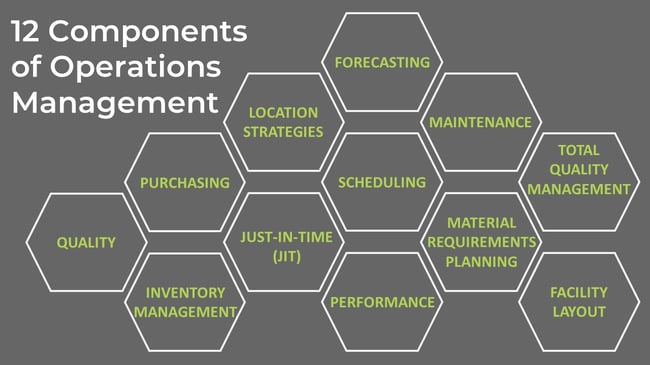Operations management is used to describe the processes concerned with planning, organizing, and supervising the overall production process. In order to successfully produce items and deliver them to customers on time, there are many components that must be addressed.

Production optimization and efficiency within the supply chain are vital to manufacturing operations. In order to maximize the use of operations management, it is essential to analyze the main components of it.
12 Main Components of Operations Management

The 12 main components of operations management include the following:
- Forecasting: This component pertains to the process of relying on historical data, facts, figures, and statistics to make decisions for production. Proper forecasting is necessary to know how much of a specific product should be produced. This will allow your facility to only produce what is needed to avoid being stuck with excess inventory or have too many shortages.
- Location Strategies: This component of operations management involves selecting the right location for your organization. A number of factors are involved in selecting the appropriate location. For example, the location of a manufacturing facility may be decided based on the availability and proximity to certain materials or skilled labor resources. Other factors such as transportation costs can be a factor, especially if the facility is located in an area of low product demand. Together, the company’s requirements, values, and goals will help determine the best location to minimize costs and potential risks.
- Maintenance: This component involves scheduling all of the regular maintenance checks and adjustments for your machines and equipment. Proper machine maintenance creates a safer workplace environment for your employees while reducing the risk of unexpected breakdowns and failures that could halt production. In addition, regular maintenance will keep your machines running at max efficiency for the longest time so that your overall production output remains high.
- Purchasing: This component pertains to ensuring that you have enough raw materials to supply the incoming demands for products. Purchasing can be done using centralized, decentralized, or combined strategies. Centralized purchasing occurs when a single department is in charge of purchasing for the entire organization. Decentralized purchasing occurs when each department or branch is in charge of purchasing to meet their individual needs.
- Scheduling: This component of operations management involves assigning jobs or operations to the right machine or labor resource. When an operation schedule is done right, it allows your company to decrease your overall production time and allow for more items to be produced and shipped out in time. This will allow you to increase your revenues and maintain a competitive advantage in the market.
- Total Quality Management (TQM): TQM is a strategy that is used to create a customer-focused organization and involves improving all employees and activities of the company to meet customer requirements. The focus of total quality management is usually on improving the processes rather than the outcomes and enables the organization to work towards having zero defects.
- Materials Requirements Planning (MRP): This component ensures that you are receiving the right amount of the right material on time to be able to complete your production on time. MRP involves taking inventory of the items you currently have, identifying which additional materials are required, and scheduling the production of materials or their purchase.
- Quality: This component is important for companies to conform to product specifications and maintain favorable relationships with their customers. Having quality products or services usually means that they meet your customer demands.
- Just-In-Time (JIT): This component refers to the process of scheduling your operations so that they can start and be completed “just-in-time” - or just when they are really needed. This technique ensures that you are limiting the number of WIP items so that materials and intermediates can flow from one resource to another to avoid needing to store large quantities of WIP items.
- Process and System Performance: This component is measured through examination, capacity utilization, or production. You can analyze and compare the expected time and quantity of items produced to the actual values to get a sense of whether your production facility is meeting its targets of falling short.
- Layout of Facilities: This component ensures that the most optimal workflow is used within your production facility. One of the 7 wastes identified in lean manufacturing involves the unnecessary movement of items throughout the facility caused by poor workflow, poor layout, and inconsistent working methods. An optimal facility layout is one that minimizes the motion of items.
- Inventory Management: This component involves keeping track of the stocked materials and items and making sure that the company is carrying the products they need at the right time. Effective inventory management will help companies meet demands by ensuring that they have the right amount of materials and finished goods to avoid having too much or too little stock.
Advanced Planning and Scheduling Software (APS) is a key software that can benefit manufacturing operations around the globe. It offers thorough insight within operations management and can take your manufacturing operation to the next level in terms of efficiency and optimization.
Advanced Planning and Scheduling Software
Advanced Planning and Scheduling (APS) software has become a must for modern-day manufacturing operations due to customer demand for increased product mix and fast delivery combined with downward cost pressures. These systems help planners save time while providing greater agility in updating ever-changing priorities, production schedules, and inventory plans. APS can be quickly integrated with an ERP/MRP software to fill gaps where these systems lack planning and scheduling flexibility, accuracy, and efficiency.
With PlanetTogether you can:
- Create optimized schedules balancing production efficiency and delivery performance
- Maximize output on bottleneck resources to increase revenue
- Synchronize supply with demand to reduce inventories
- Provide company-wide visibility to capacity
- Enable scenario data-driven decision making
The implementation of Advanced Planning and Scheduling (APS) software will take your manufacturing operations to the next level of production efficiency, taking advantage of the operational data you already have in your ERP. APS is a step in the right direction of efficiency and lean manufacturing production enhancement. Try out a free trial or demo!
Related About Video
APS Resources
Topics: operations management




















LEAVE A COMMENT